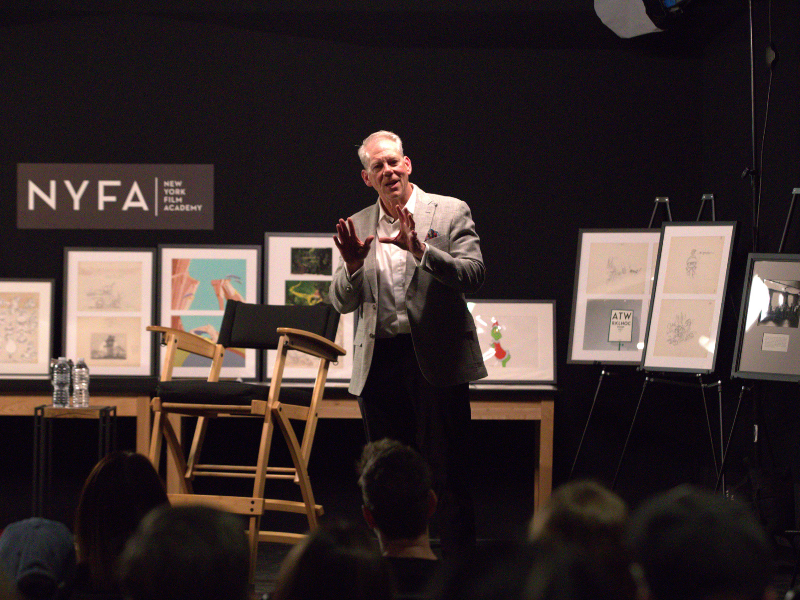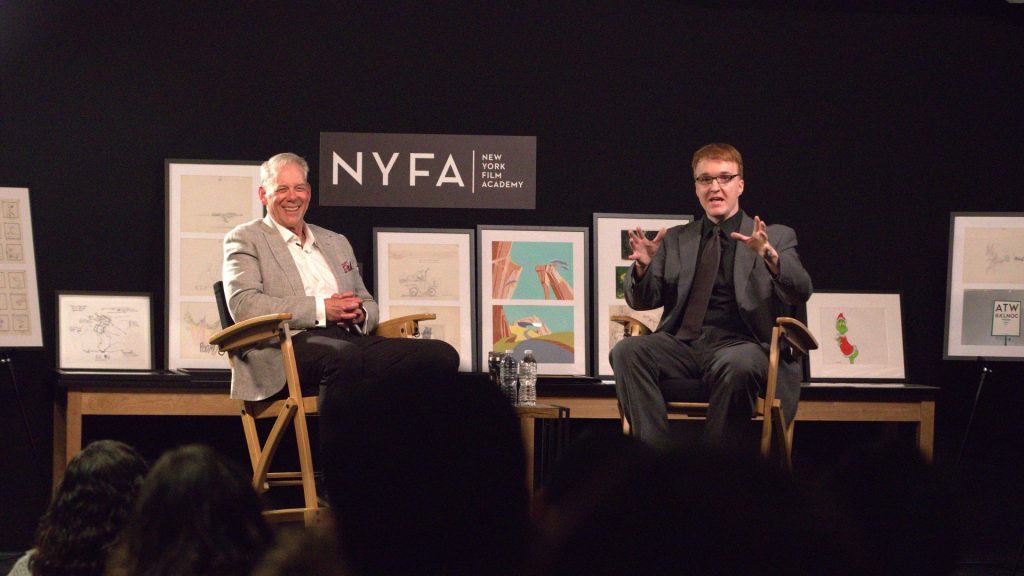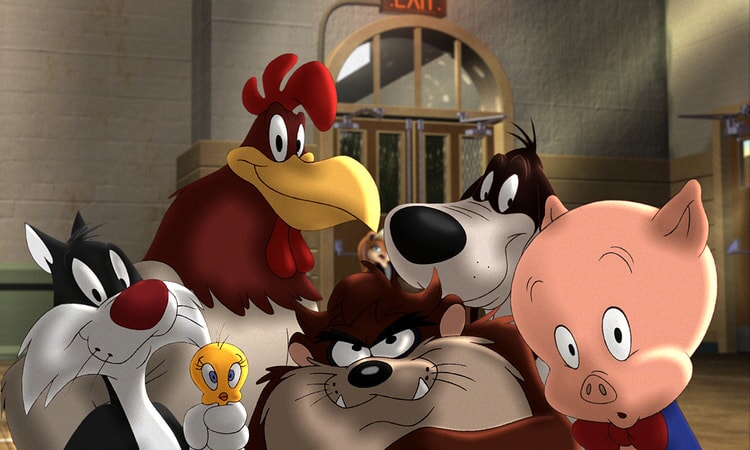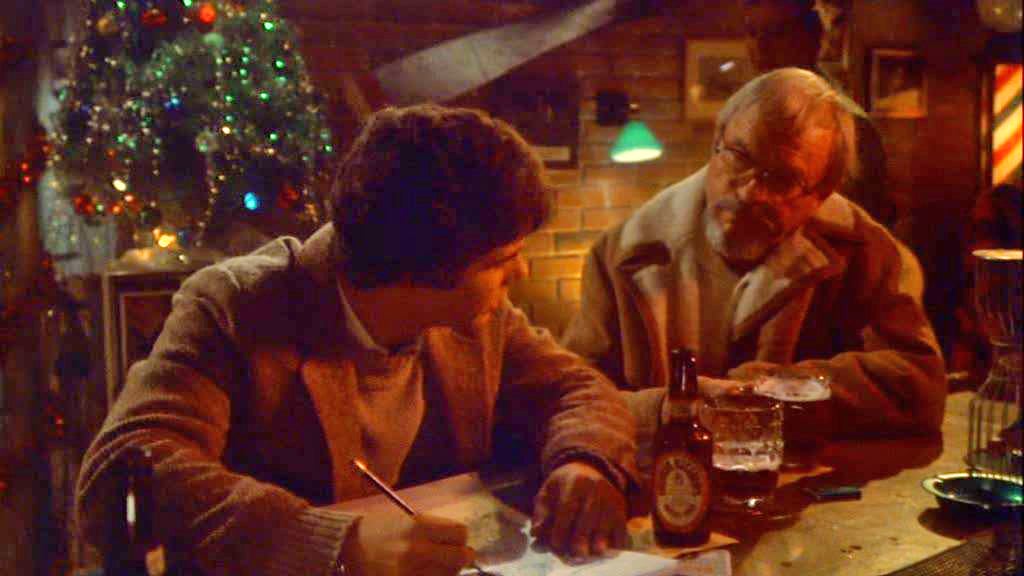Craig Kausen, grandson of the legendary animation filmmaker, Chuck Jones, spoke in a special guest speaker event for NYFA students and faculty. Kausen discussed the work and career of Chuck Jones, whose name is synonymous with characters from Looney Tunes, Tom and Jerry, and Merrie Melodies.

Who was Chuck Jones? An animation legend in pictures, sketches, drawings, and slides
Presenting to a packed room at the NYFA Los Angeles Riverside building theater, Craig Kausen unveiled the cinematic journey of his animation-pioneering grandfather. Kausen is the President and current Chairman of the Board of the Chuck Jones Center for Creativity. The Center prides itself as a place to unleash the creative spark in everyone, serving individuals from childhood to their golden years through a wide range of experiences based on Chuck Jones’ unique philosophies of education while incorporating his well-loved films, characters, writings, and art.
Kausen is a graduate of UCLA with a degree in computer engineering, after which he worked at Hughes Aircraft and taught computer engineering and computer science at the collegiate level. In 2003, he took the company’s helm as President and CEO. Since then, Kausen has lectured and taught for and about the art industry over the past two decades across the United States.
The guest speaker’s grandfather, Chuck Jones, was an American animator, director, and voiceover actor, with a career spanning six decades and is considered a pioneer in animation. Best known for his legendary contributions to the Golden Age of Animation at Warner Brothers Studios, Jones created beloved characters such as Bugs Bunny, Daffy Duck, and the Road Runner.
Jones’ distinctive style, which emphasized expressive characters, intricate timing, and clever storytelling, left an indelible mark on the world of animation. His portfolio includes iconic cartoons like Duck Amuck, What’s Opera, Doc? and How the Grinch Stole Christmas!
Throughout his career, Jones received numerous awards, including three Oscars, an honorary Oscar for Lifetime Achievement, and a Smithsonian 150th Anniversary Medal of Achievement, solidifying his status as one of the greatest animators in history.

The Q&A portion of the NYFA event was moderated by NYFA’s very own Paul Laverack, Instructor of Film History within the Liberal Arts & Sciences Department. Laverack earned his MFA in Screenwriting and MA in Mass Communication from Cal State Northridge, following his BA in Theater from Elmira College in New York. Having toured the country as a performer in musical theater productions, and producing educational shows for children, Laverack worked as a Video Producer for the Families in Schools Foundation, creating over 125 episodes for his YouTube channel, Read Aloud with Mr. Paul.
What we can learn from the Chuck Jones collection
Chuck Jones grew up during the Roaring 20s, found work during the Great Depression, and lived through World War II, the Korean War, and Vietnam. Much of Jones’ work reflects more than half a century of pop culture, history, art, and political changes. Beginning his career as a cell washer, wiping the cells used for hand animation, the young animator met and kicked off his career alongside Tex Avery and Bob Clampett.
While working for Disney briefly during a shutdown of the Warner Brothers animation studios, Jones met Dr. Seuss, Mike Maltese, and other powerhouses in the burgeoning space of feature-length animations.

Chuck Jones’ professional meeting with Dr. Seuss resulted in his role as director and co-producer of the television special and adaptation of “How the Grinch Stole Christmas!” (1966). Learn about Creative TV & Movie Adaptations Featuring NYFA Faculty, Alums, and Rising Stars by reading our Film School blog article.
The television special and story, known to be a part of many a child’s Christmas experience, is better recognized by millennials in the live-action movie adaptation How the Grinch Stole Christmas (2000) directed by director and NYFA Guest Speaker Ron Howard.
For Jones’ hard work, intricate attention to detail, and masterful storytelling, he won three Academy Awards in his lifetime along with an Honorary Academy Award for his lifelong career in animation and mastery of storytelling. Guest speaker Kausen discussed the laborious process of creating a six-minute animation in his presentation to the school by showcasing examples of hand-drawn frames from various selected pictures. The process could take between 6 to 10 months, a feat almost unthinkable today.

In a lesson of patience, and to underline how much animation has evolved following the advancements in digital technology, Kausen presented the storyboarding, layouts, and lock-step processes that lead to the animation segment of story creation. According to the guest speaker, Jones would create around 500 layout drawings, which determined what a character was doing at the 24th of a second (the original film reels were played at 24 frames).
“Creativity without opposition is like playing polo without a horse.”
– Chuck Jones
Throughout the presentation, Kausen engaged the audience with delightful stories of Jones’ time as an animator at Warner Brothers. Recalled from moments his grandfather would share stories with the family, Kausen described Jones’ experiences working for difficult studio producers who had little to no animation experience.
In remarkable stories of perseverance and resilience, Jones and his colleagues would derive fun in playing practical jokes at the expense of their producers or by embracing their own antagonists by writing them into new characters. Kausen regaled the audience with stories of Jones’ attempts to circumvent the censorship boards, unleashing a deeper, more human, and related cast of characters that we learned to love in both movies and television.
In an anecdote about creative inspiration, Kausen recalled a story his grandfather shared about one of his producers’ feelings about the character Pepe Le Pew. Kausen said, “[this producer] didn’t think skunks were funny. Which drove Chuck to make For Sentimental Reasons, which won the Oscar.”
In his early years, Chuck Jones faced difficulty finding employment following the completion of art school. Kausen shared, “[Chuck came out of] art school in 1929 and there was 30% unemployment at the time. You’re in Hollywood with people who– it’s a fledgling industry, the film business, let alone the animation business–and [Chuck] tried to find a job doing something he loved. He had been a janitor and then stumbled into becoming a cell washer. The idea of working his way up and not knowing where he was going–Chuck admitted he was lazy. He was 19. He didn’t know what he was doing. But then, he was pulled into Warner Brothers as an in-between, or assistant animator.”

At a time when Disney reigned king studio of animation, and when studios were considered notoriously cheap, Kausen described the appalling way work was conducted in the Hollywood system. According to the guest speaker, animators were often expected to pay to work on apprenticeships, meaning they owed the studio money to gain training and work onsite. Once they graduated, animators could “work for free,” which meant they were no longer held under obligation to pay for the work they output.
Following his experiences collaborating with the United Auto Workers union and campaign work for President Franklin D. Roosevelt’s presidential election, Jones’ liberal and humanitarian passions became a recurring theme in his creative work.
Character or Story? A question on creativity and the industry
According to Kausen, Jones always prioritized the character in his world. If he understood a character, he understood how they would react in any given situation. Channeling his grandfather on creativity, Kausen shared his insights on how to be creative.
“There’s a unique, creative genius inside of every single person. If you figure out how to listen to it at all times, and it’s not always there, but if you get very quiet, you can hear that creative genius, and then you’ll have to listen to it.”
– Craig Kausen
Creatives now, in our modern age, ponder about the future of the industry, now that filmmaking and animation are well past their infant stages as was the case in Chuck Jones’ early days. For the legends, Chuck Jones, Fritz Freleng, and Walt Disney, “animation imbues everything we do,” said Kausen.
An animator, family man, and educator
When asked about his closeness and relationship with his grandfather, Kausen said that they had been close until Chuck’s passing when Craig was forty years old. For several years, Craig traveled with Jones to attend educational events, like the one conducted at NYFA, to record and observe, and learn from the animator in numerous Q&A-style interviews.
According to the event Q&A moderator and NYFA Instructor Paul Laverack, “More than once, I found myself leaning forward in my seat to hear more, and I was on stage with Kausen.”

The event was a huge success, and Laverack noted that “the ultimate signal of the event’s success came from the students in attendance. While they waited in line to see Chuck Jones’ production art up close, several expressed astonishment at how much fun they’d had and how much they’d gotten from the event. It isn’t just that Chuck Jones’ characters—Bugs Bunny, the Road Runner, and the Grinch—endure, which they do; it was that Chuck Jones’ artistic spirit had come alive in the room that night.”
Bring Your Characters to Life at NYFA
Students interested in animation can study at NYFA’s 3D Animation & VFX School at the Los Angeles and New York City campuses, and online. Animation is also a concentration option under NYFA’s BFA in Entertainment Media, which offers students the chance to explore a variety of creative disciplines that best align with their talents and interests before immersing themselves in the advanced study of a concentration.